The Last Supper, the famous work of Leonardo da Vinci, is located in Milan in its original place, the Refectory of the convent of Santa Maria delle Grazie.
The work was commissioned by the Duke of Milan Ludovico Sforza known as “il Moro”, who wanted to transform the religious complex into his family mausoleum.
Since 1980, together with the Basilica and the Convent, the Cenacolo Vinciano is part of the UNESCO World Heritage Sites.
In this article we are going to provide you with some useful tips to plan your visit, including the website link to book the Last Supper tickets as well as some interesting historic and artistic information.
Table of Contents
- How to get there
- Guided Tour
- Free Tickets
- Santa Maria delle Grazie
- The Last Supper
- The Last Supper Tickets
- History
- The Scene
- Meaning
- The Crucifixion
How to get there
The Basilica of Santa Maria delle Grazie is in the homonymous square and is located in the Magenta area, just outside the historic center of Milan.
The nearest metro stops are:
- Cadorna FN Green Line M2 (the line passes through both the Central Station and Porta Garibaldi);
- Conciliazione or Cadorna FN Red Line M1 (the same line which reaches also the Duomo stop).
In both cases you will then arrive at destination with a short walk of about ten minutes.
You can also reach the museum by Tram with line 16 (the line also passes in the Duomo area) and with the Bus lines 50 and 169 (the stop is in via Boccaccio).
To check rides and schedules, however, I advise you to install the official App of ATM, the Milanese Transport Company, on your mobile device.
The Last Supper – Guided Tour
If you want to live a complete experience that includes both the detailed explanation of the famous painting by Leonardo and the visit to the church and the cloister, then we recommend you to attend the guided tour.
The visit lasts one hour and fifteen minutes. The certified guide speaks English, but you can choose also Spanish.
Voucher includes the entrance ticket and earphones if the visit is made with a group of at least five participants.
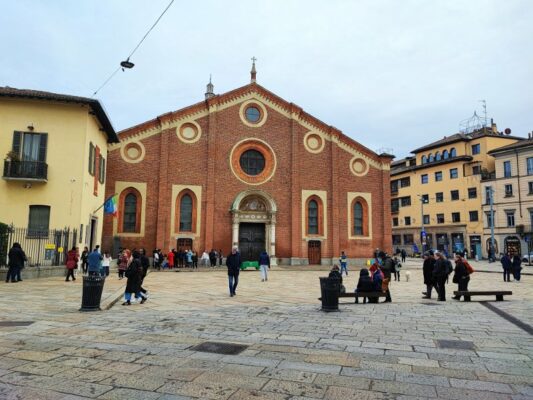
Santa Maria delle Grazie
Free tickets
Some categories can access the museum free of charge, for example the disabled and their companions, the teaching staff of schools, Under 18 EU and non-EU, ICOM members (International Council of Museums).
The complete list of all categories is still available on the website of MIBACT, the Ministry for Cultural Heritage and Tourism.
Municipality of Milan has also promoted the initiative that provides free entry to all the civic museums of the city on the first Sunday of the month, booking the entrance well in advance.
The structures that adhere to this project are Cenacolo Vinciano, Museo del Novecento, Pinacoteca di Brera, Gallerie d’Italia, Civic Aquarium and the Museums of the Castello Sforzesco.
Santa Maria delle Grazie
Gaspare Vimercati, a wealthy officer of the Sforza army, donated some land to the Dominican friars of Pavia in Milan. It was the year1460.
At that time the area was occupied by two modest buildings. One gave residence to the soldiers of Vimercati and the other housed a small chapel, inside which there was the fresco of the Madonna delle Grazie.
The monks, thanks to the financial help of the Sforza family, commissioned the works for the construction of a Church, with an adjoining convent to be named after the Our Lady of Grace (italian: Madonna delle Grazie).
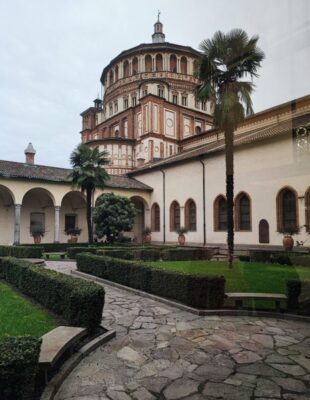
The Cloister
The works, led by the architect Guiniforte Solari, began in 1463 and ended in 1469. The Church instead, in Lombard Gothic style with three naves, was completed in 1482 and incorporated the ancient chapel.
That of the Graces was a very important construction site that attracted numerous architects, artists and painters.
The convent was divided into three cloisters. The first was used by the troops of Vimercati and then demolished in 1897, the second instead was called the Great Cloister and housed the cells of the friars.
Finally, the third, the Cloister of the Dead, was located near the ancient chapel, where today stands the Chapel of the Rosary, the last one that you will find in the left aisle of today’s Basilica.
The Last Supper
As mentioned at the beginning, Leonardo’s painting is located on the north wall of the Refectory, the place where the Dominican friars gathered to eat meals. It was a place of meditation as well.
The room has a rectangular plan and is very large. The Last Supper is located on one of the two smaller sides, while on the other there is the painting of the Crucifixion by Giovanni Donato Montorfano.
The two paintings are closely linked to each other as they depict in a chronological manner two events of the Christ’s Passion.
On the long walls there are other decorations, including garlands and rounds containing the bust of a Dominican friar.
Among those in the room, the Last Supper was probably the first painting to be begun but also the last to be finished.
The Last Supper tickets
For any type of entrance, the reservation is mandatory.
For ticket rates, opening hours, availability and any reservations, I suggest you consult the website of the Museo Cenacolo Vinciano.
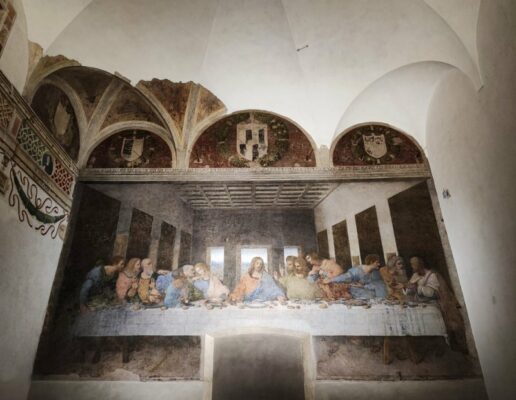
The Last Supper
History
From the documents held by historians, it is assumed that the work was made between 1494 and 1498. A technique similar to tempera painting on dry plaster was used, plus some glazes made with oil.
This choice allowed Leonardo to work more calmly, better managing the times, but immediately determined the fragility of the work.
In fact, the painting has always been subject to the humidity that makes the wall ooze water, especially on particularly sultry days or in presence of sirocco wind.
Moreover, in 1600, to open a door, the portion of the painting corresponding to the legs of Jesus was removed and the “wound” is still clearly visible. Finally, in 1943 the bombings during the Second World War caused extensive damage to the entire complex.
Over the years, many restoration works have been carried out, the last of which lasted about twenty years and ended in 1999.
The Scene
The scene depicted was taken from the Gospel of St. John and was painted from left to right.
At the top there are three lunettes that contain the coats of arms of the Sforza family, framed in a garland.
In the lower part there is the perspective representation of the room in which the scene takes place, with the wooden coffered ceiling and the tapestries hanging on the walls.
In the background there are two windows and a door that illuminate the room. If you pay attention, in the panorama that can be glimpsed from the door, a bell tower appears right next to the head of Jesus.
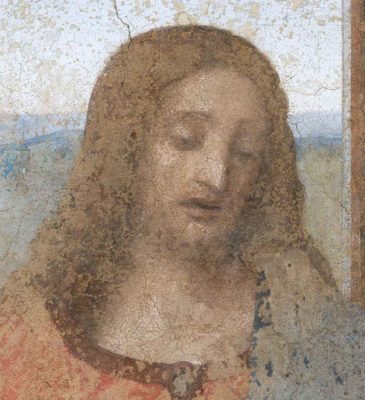
Christ’s face (© cenacolovinciano.org)
Meaning
The scene depicts the moment when Jesus and the apostles gather to celebrate Passover.
Jesus Christ is positioned in the center and is isolated from the twelve apostles, grouped into trios.
His mouth is open and he is probably revealing that some of them will betray him, while with his left hand he points to a piece of bread.
Behind him a door and the two windows in backlight make his figure stand out even more, appearing sharper than the others.
The hands of the apostles are all turned towards Jesus and guide the eye of the observer precisely towards the main figure of the painting.
To his right (the left of the beholder), in the first trio you can recognize Peter with a white beard, John, the favorite disciple of Jesus, and Judas.
Peter seems to suggest to John to ask Jesus who might be the traitor. In front of them, with a darker face, stands Judas.
Jesus says that the traitor is the one from whom he will draw the bread and in the painting we see Judas stretching out his left hand while holding tight in the right one the bag containing the thirty pieces of silver, the compensation received for the betrayal.
The other apostles have other reactions: there are those who confabulate, those who raise their hands and gesticulate, who says “is it me”?
Thomas, who stands in the first trio to the left of Jesus, points to heaven with a finger.
If you pay attention the painting contains some very interesting details: the reflection of the colors of the clothes of the apostles in the metal plates, the beauty of the glasses and the embroidery of the tablecloth.
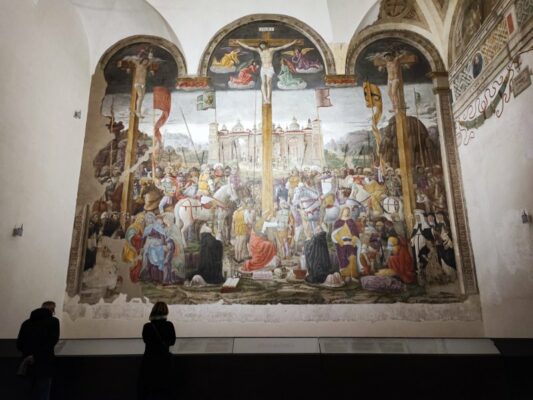
The Crucifixion
The Crucifixion
The painting of the Crucifixion was made by Giovanni Donato Montorfano. It was completed by Leonardo with the insertion of portraits of the dukes and their sons.
The scene is set in an imaginary Jerusalem and the three crosses are placed under three archways. In the picture the figures of Dominican friars are also clearly visible.
Photo Credits: two photos have been downloaded from the official website of the Museum.


0 Comments